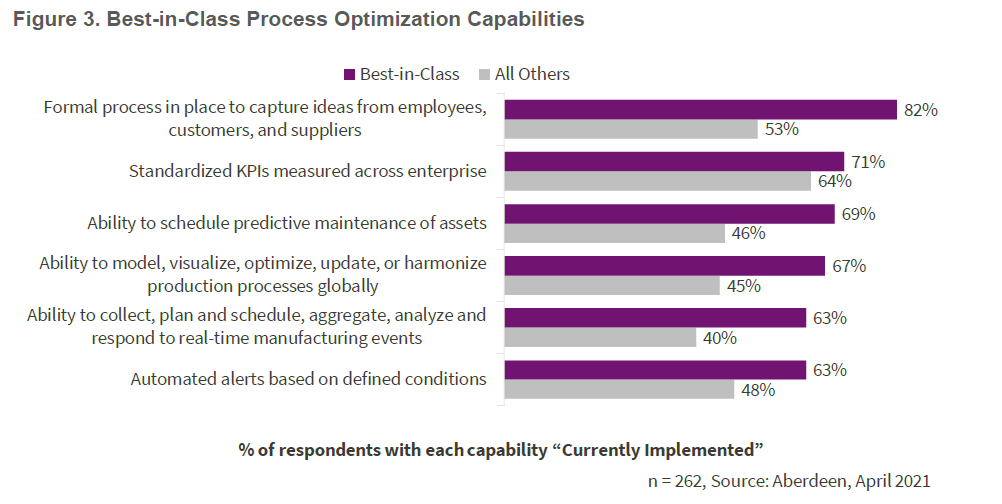Breadcrumb
Process Optimisation is the pay-off for Best-in-Class Manufacturers
Written by Edin Osmanovic
Global Account Manager
In my last article we discussed how Best-in-Class manufacturers had already made significant progress on their digital transformation journeys and were concentrating on process optimisation to exploit their new infrastructure.
So, the natural next step is to examine more closely just what these Best-in-Class manufacturers are doing today and, more importantly, the benefits they are deriving from their efforts. The latest Aberdeen research attaches some pretty staggering benefit numbers to these activities.
Process optimisation is not a new term and it addresses many of the pressures facing manufacturers today. Re-evaluating processes allows manufacturers to cut down on waste, reduce production time and increase quality. In fact, all manufacturers will have KPI’s in place in these areas. So what are those market leaders doing differently? Well, it appears they are already taking process optimisation further by looking at areas such as scheduling predictive maintenance, modelling processes globally and responding in real-time to events.

Aberdeen were able to quantify the benefits that Best-in-Class manufacturers were achieving. Here you can see just how the foundation of digital transformation pays off by raising process optimisation opportunities to another level.
Best-in-Class companies generate 31% more New Product Introductions that meet production targets.
That’s an amazing statistic. With process in place, Best-in-Class manufacturers can more efficiently turn an idea into a prototype and a prototype into a finished product.
Best-in-Class companies see a 2.4 times greater year-on-year decrease in production downtime.
Analytics and systems to schedule predictive maintenance is rapidly reducing downtime and the costs associated with unplanned maintenance.
Best-in-Class companies are seeing a 1.4 times greater year-on-year decrease in time to decision.
Global standardisation and access to real-time data is enabling executives, as well as those on the production line to make faster, more accurate and more profitable decisions.
Best-in-Class see 37% more products meeting quality targets upon design release.
The leading manufacturers do not just have vertical real-time data transparency from global level to factory floor – they also have a horizontal view across all manufacturing areas. These systems enable visibility into real-time quality and compliance data, helping to catch defects early and radically improve quality results.
Best-in-Class companies see a 34% increase in year-on-year in Overall Equipment Effectiveness (OEE).
Dashboards visualising OEE and related metrics improve optimisation by allowing leaders to easily view data related to productivity. Plant managers can use this data to build models of the factory floor and further optimise equipment utilisation.
The upshot is that manufacturers leading their field are aiming much further than digital transformation. They are using this transformation as the foundation to further optimise their processes for competitive advantage. They are using technology as an enabler to innovate and to drive efficiencies to cut costs while maintaining quality. Can you afford not to be Best-in-Class?
"Process Optimization in Manufacturing: The Key to Best-In-Class Success" research.
Read more insights…
blog
Connecting Our Customers to Tomorrow: A New Era for Panasonic Connect Europe
In today’s dynamic business landscape, transformation is no longer a choice. It’s a necessity.
blog
Navigating Change: How Technology Can Power European Business Transformation
European organisations face a challenging 2025 with an uncertain socio-economic backdrop but there are also incredible opportunities being delivered by the latest technologies, explains Shusuke Aoki, new CEO & Managing Director at Panasonic Connect Europe. Now is the time to be bold and grasp that technological opportunity.
whitepaper
Integrating Generative AI into Sales
Until the public release of ChatGPT in November 2022, the debate about the impact of generative AI on work was largely academic. In the short time since its launch, the discussion has become very real. Generative AI is changing the way people work – and fast.
blog
The Future of B2B Marketing Requires a New Marketer
The last industrial revolution changed the way we work forever. The next one is happening right now. But this time, it’s not about steam engines or assembly lines. It’s about artificial intelligence (AI) and its power to reshape B2B marketing as we know it.
Sorry there was an error...
The files you selected could not be downloaded as they do not exist.
You selected items.
Continue to select additional items or download selected items together as a zip file.
You selected 1 item.
Continue to select additional items or download the selected item directly.
Share page
Share this link via:
Twitter
LinkedIn
Xing
Facebook
Or copy link: